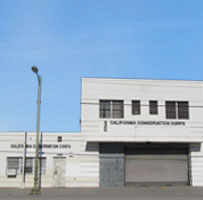Farmers' Markets: A Healthy Alternative
Robin Alvarez, a former member of the historic Los Angeles gang The Playboys, leads us on a trip down Main St. and through his life as a gang banger.
Famliy-owned, Word of Life Christian Bookstore, is celebrating 50 years of operations on Main Street. The family owns three location in Los Angeles and is considered one of the largest outlets for Christian literature in Southern California.
Relics of the post-WWII era still stand tall along Main Street – air raid sirens. Although they were originally installed to alert Angelinos of an impending air strike, they have been configured to serve as part of the statewide Emergency Alert System. During the 1992 Los Angeles riots, certain public services were stretched beyond their limits and while some eventually expanded, some were discontinued. Listen to find out how the city responds to crisis, whether it be natural disasters or urban unrest.
Where does one go to buy groceries? The answer seems obvious -- like a peculiar update of "Who's buried in Grant's Tomb?" Yet if you live in the neighborhood bisected by Main Street in South Los Angeles the question is far from rhetorical and hardly trivial. The problems of purchasing groceries around Main Street is a vital issue of public health, and it is a topic fraught with bureaucracy and unintended consequences.
For public health experts Main Street provides a prime example of the dire lack of quality healthy foods available to residents of South Los Angeles. Dr. LaVonna V. Lewis, a USC school of Policy, Planning, and Development researcher specializes in health disparities. According to Dr. Lewis, far greater numbers of people die of complications stemming from obesity, heart disease, and diabetes than in wealthier areas of Los Angeles County. Furthermore, the sorts of groceries available on and near South Main Street may contribute to the high rate of these diseases in the area.
"The prevalence [of these diseases] is higher here than almost anywhere else in LA County," said Lewis. "Can I say that living in South Los Angeles causes these diseases? That's the subject of further research, but certainly for those living in South LA making the kind of healthy lifestyle choices that can prevent [them] is much tougher."
A trip down Main Street illustrates the lack of grocery options in the area. Driving south on Main Street from Adams Boulevard, one first encounters a wide array of "corner store"-style markets and bodegas. These stores traffic in foods and beverages that are high in sugar, sodium, and fat. For residents that do not have the means or time to travel outside their immediate area, such stores can serve as a primary source of groceries.
"These markets are more profitable here than in other locations because residents are 'captive' to the store and the products they offer," said Lewis.
Many of these stores also offer produce, dairy, and even meats that are poorly regulated. In many instances produce, dairy, and meats are sold that have long since expired or gone rotten. Again, residents on Main Street can be "captive" to these products if they do not have the ability to travel outside the area. According to the Community Health Council, a non-profit dedicated to eliminating health disparities in South Los Angeles, residents in South LA have access to 70% fewer retail food stores than the average California resident.
If one travels south on Main Street to the intersection of Main Street and 54th Street, they will find a "proper" chain grocery store -- Food 4 Less. This supermarket is representative of most chain supermarkets in the area. The selection of produce is limited, and often of questionable freshness. Organic produce and dairy is non-existent, and meats and poultry are all processed and prepackaged. There is no fresh deli or bakery in-store. In South Los Angeles 38% of retail food stores offer non-fat milk, compared to 80% of similar stores in West Los Angeles.
A statement from the CHC reads, "Without the support of the marketplace, the options available to most African American residents in [South Los Angeles] are either unhealthy or dangerous, on the one hand, or time-consuming and costly, on the other. In other words, those Angelenos who most need nutritional support in order to get healthy foods into their shopping carts are among those least likely to get it."
Prepackaged dry-goods in Food 4 Less are almost universally high in sodium and trans-fats, and the store offers no alternatives to rows and rows of soda, candy, and sugary cereals. Lewis said that supermarkets like Whole Foods or even Ralph's one can find in more affluent areas are barely recognizable as the same sort of business.
"It would be much quicker to talk about how they are the same, the difference is that significant. Whole Foods is like the Bentley of markets: lots of locally grown and organic foods, and many more healthy options -- low fat, low salt, low sugar," said Lewis. "[On the other hand] the name 'Food 4 Less' pretty much says it all."
It is not just a lack of availability of alternatives to unhealthy foods, but also a lack of education. Many shoppers on Main Street are unaware of the importance of a healthy diet, and have no exposure to healthy alternatives.
The situation is not hopeless, however. One of the CHC's initiatives is the Neighborhood Food Watch , which encourages citizens to report on local markets that sell rotten or expired foods. Conversely, The NFW encourages residents to report clean markets that offer fresh and healthy foods on their blog.
The website also offers times and locations of local farmers markets in South LA, which can provide residents with fresh and local organic produce without the Whole Foods price. Currently nine different farmers markets operate in South Los Angeles at some point in the week, many in the immediate vicinity of Main Street. (See audio slide-show)
Still, residents on Main Street seldom encounter fresh, let alone local and organic, foods in their daily lives. As a drive down Main Street illustrates, the question of where one buys groceries is not just a matter of preference. It is an issue of public health.




